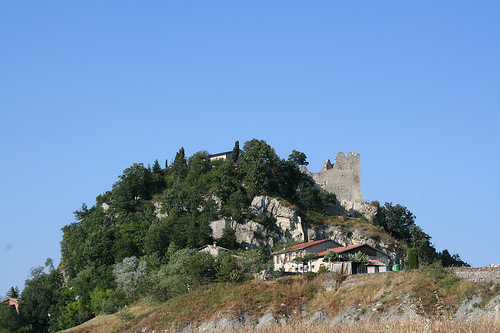
Location: 18 km (11 mi) South of Reggio Emilia Map

Canossa Castle (Castello di Canossa) is a historic fortress located in the municipality of Canossa, in the province of Reggio Emilia, northern Italy. Perched atop a white sandstone cliff in the Apennine Mountains, at an elevation that provides commanding views over the surrounding valleys between the Enza and Crostolo rivers, the castle was once one of the most impregnable strongholds in medieval Italy. Built in the 10th century, it served as a key defensive structure controlling Apennine passes and plains, symbolizing the power of the Canossa family (also known as the Attonidi). Today, it exists primarily as evocative ruins, declared a national monument in 1878, and attracts visitors for its historical significance, archaeological remains, and scenic landscape.
The origins of Canossa Castle trace back to around 940 AD, when it
was constructed by Adalbert Atto (also known as Azzo Adalberto), a
Lombard nobleman and founder of the House of Canossa. He established the
fortress on the summit of an isolated rocky hill, possibly over remnants
of a pre-existing Roman settlement. The initial structure included a
residence, a convent housing 12 Benedictine monks, and the Church of
Sant'Apollonio, forming the nucleus of a complex defensive system. By
the mid-10th century, the castle demonstrated its strategic value when,
in 950, Adelaide of Italy (widow of King Lothair II) sought refuge there
from Berengar II of Ivrea, who besieged it unsuccessfully for three
years.
The castle reached its zenith under Matilda of Tuscany
(Matilda di Canossa), a powerful countess who inherited it in the 11th
century. She expanded the fortress in 1106, enhancing its fortifications
to accommodate larger gatherings, including papal courts. Matilda's era
marked the castle's peak influence, as it became intertwined with the
Investiture Controversy—a power struggle between the Holy Roman Empire
and the Papacy over the appointment of church officials.
Following
Matilda's death in 1115, the castle changed hands multiple times.
Emperor Henry V claimed it in 1116, but it faced ongoing disputes
between imperial and papal forces. In 1255, troops from Reggio Emilia
besieged and partially destroyed the castle and its church, though the
Canossa family rebuilt it soon after. Landslides in the 13th-14th
centuries damaged southern sections, prompting reinforcements to the
northern access. By 1409, it fell under the control of the House of
Este, who held it (with brief interruptions) until 1796. Notable
custodians included the poet Ludovico Ariosto, who served as castellan
in 1502 for six months.
The 16th century brought further turmoil: In
1557-1558, Ottavio Farnese, Duke of Parma, bombarded the castle, causing
a major northern landslide and destroying the northeastern entrance. The
Este family restored parts of it in 1559, but by the late 16th century,
under the Ruggeri family, it was converted into a more stately residence
rather than a military fortress. Ownership shifted to the Valentini
family in 1642, but the castle gradually fell into neglect. Rebellious
locals ousted the Valentini in 1796 amid the formation of the Republic
of Reggio. Natural disasters, including landslides in 1821, 1831-1832,
and 1846, accelerated its ruin. In 1878, the Italian government acquired
the site, declaring it a national monument to preserve its historical
value.
Canossa Castle exemplifies medieval fortified architecture,
ingeniously adapted to its rugged terrain. The site spans a hill with a
60-meter height variation, featuring steep rocky sides on the south and
northeast, making it naturally defensible. The original design included
a triple line of defensive walls, with barracks and servant residences
situated between the outer two layers. Key elements comprised a central
palace, a monastery, and the Church of Sant'Apollonio, all integrated
into a layered system that controlled access and provided overlapping
defenses.
Expansions over time added complexity: The 11th-century
enlargements under Matilda included provisions for larger assemblies,
with structures like tower-gates separating sacred and residential
areas. Vestiges today include the apse and ruins in the southern area
(likely for storage), foundations of a tower-gate, and a raised eastern
tower section. Post-13th-century repairs focused on stabilizing northern
access after landslides. By the 16th century, restorations incorporated
more residential features, such as palace walls built by the Ruggeri
family.
Recent 3D surveys using laser scanning and drone
photogrammetry have revealed precise details, such as the alignment of
historical reconstructions with current ruins. These models show a
global alignment error within 10 cm territorially and millimeters
architecturally, highlighting how the castle's design intertwined with
the hill's morphology for optimal defense. Orthoimages and digital
terrain models from these surveys aid in ongoing preservation efforts.
The castle's most famous episode is the "Walk to Canossa" (or "Road
to Canossa") in January 1077. Amid the Investiture Controversy, Holy
Roman Emperor Henry IV, excommunicated by Pope Gregory VII, traveled
barefoot through snow to the castle to seek absolution. Hosted by
Matilda di Canossa, who mediated, the pope granted forgiveness after
three days of penance—an event symbolizing the triumph of papal
authority over imperial power and coining the phrase "going to Canossa"
for acts of humiliating submission.
Other significant moments include
Adelaide's refuge in 950, the 1255 destruction, and Ariosto's brief
tenure in 1502, during which he may have drawn inspiration for his
literary works.
Today, Canossa Castle consists of limited ruins—fragments of walls,
towers, and foundations—due to centuries of sieges, landslides, and
erosion that have reduced the fortified area significantly. The site
remains extraordinarily evocative, with panoramic views of the
Emilia-Romagna countryside. Archaeological excavations in 1877 and 1893,
led by figures like Gaetano Chierici, uncovered numerous artifacts, now
displayed in the on-site Naborre Campanini National Museum (opened in
1893 and reorganized in 2002). The museum, managed by the Matilda of
Canossa Cultural Association since 2017, features exhibits on Matilda's
era, excavation history, and a nature trail, including a historical
reconstruction model.
Restoration efforts continue, with hill
stability monitoring initiated in 2018 to combat ongoing erosion. The
ruins are accessible via a narrow paved road on the southwest side and
are a popular tourist destination, offering insights into medieval
history amid a dramatic natural setting.